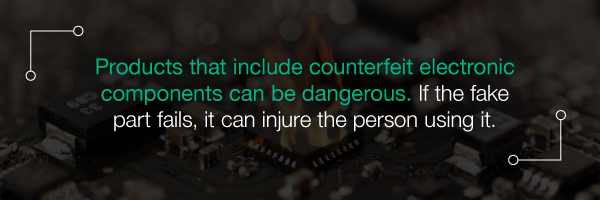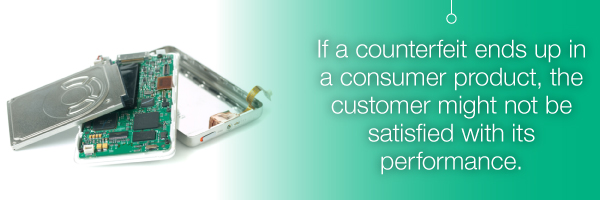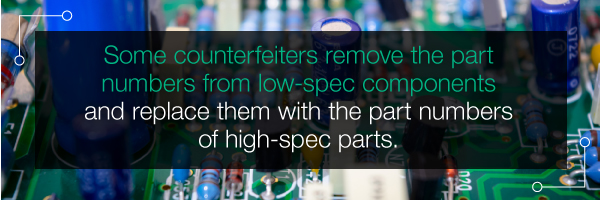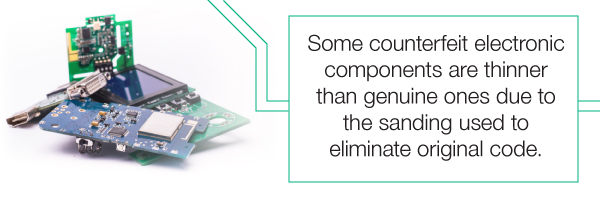
Counterfeits show up in virtually every industry, so it's not surprising counterfeit components are a problem in the electronics industry. Although governments, companies and other stakeholders have been working to prevent counterfeits from entering the market using numerous methods, they still sometimes make it through. These fake parts can cause issues with product performance, as well as safety risks.
If you work with electronic equipment, you need to have a strategy in place to help you avoid fakes and detect counterfeit electronic components in case one ends up in your facility. To protect yourself from accidentally using forged parts in your projects, you need to ensure consistency high-quality and genuine supplies and be able to identify fake components or work with a partner company that can handle these risks for you. This article will outline tips for keeping counterfeit electronic parts out of your company's electronics.
Why Are Counterfeit Electronic Components Problematic?
Never underestimate the importance of electronic components in your projects and your business' operations. Even small parts can make or break a device. If certain items break or don't perform as expected, they cause issues related to safety and product performance. Counterfeit parts are problematic mainly because they are more likely to malfunction than genuine parts are because of their lower quality. Despite this decreased quality, you still pay a premium for them, since their manufacturers attempt to pass them off as legitimate, higher-quality pieces.
Safety Concerns
Products that include counterfeit electronic components can be dangerous. If the fake part fails, it can injure the person using it. It might also cause the product it's used in to function incorrectly, in which case the forged element might cause injury indirectly. For example, fake pieces can lead to short circuits, which could cause a fire. The implications of this could, of course, be disastrous.

Electronic components are essential to many different sectors, including aerospace, the medical industry, the military industry, communications and many more. In these industries, if a device malfunctions, the results can be deadly. If medical devices don't function correctly due to the use of counterfeit integrated circuits and other electronic parts, they might not provide accurate test results, leading to inaccurate correct diagnoses. They could even directly harm the patient. If aerospace parts contain counterfeit electronic components, they may fail, putting the lives of pilots and crew in danger. And nobody wants a mobile phone that might explode in their hands.
You don't know the origins of counterfeit electronic components, so you cannot count on them to function reliably. Because of this, they do not meet safety standards and present safety risks to a company's workers, customers and others who handle them.
Worsened Performance
Even if a fake electronic item does not cause a safety incident, it will likely cause the performance of the final product to suffer. The product may fail entirely, or it might not perform as optimally or efficiently as expected. If you're using a device with a fake component at work, it can decrease your workers' productivity and performance. If a counterfeit ends up in a consumer product, the customer might not be satisfied with its performance. Although the culprit was just one forged component, that part could damage the company's reputation in the eyes of that customer forever.

Increased Expenses and Revenue Loss
Losing productivity in the workplace can lead to lower revenue, as can dissatisfied customers. You might also find you have to replace those fake elements or the entire product, hurting your bottom line even more. The Semiconductor Industry Association estimates semiconductor companies in USA lose about $7.5 billion each year due to fake parts — and that's just one industry in one country. Estimates for the impact for all businesses are as high as $250 billion.
Electronic components that malfunction can cause damage to other parts of a product, as well. The problems caused by fake components can impact the circuit they're on and other nearby elements, making the damage more costly and harder to repair. If an electronic product is part of an industrial process, it could damage a much larger system if it malfunctions, potentially causing downtime at a manufacturing plant and increasing the costs of the broken part far beyond the expense of replacing it. It may have been just one small forged component, but its impacts can be widespread.
What Types of Counterfeit Electronic Components Are There?
Counterfeit electronic components can come from a variety of distributors, resellers and manufacturers in countries around the world. These counterfeiters use many different methods to produce and distribute their fraudulent parts, so forged goods can show up in many various forms. This is by no means an exhaustive list, but these are some common types of faked electronic components.
• Low-spec components made to look like high-spec ones: Some counterfeiters remove the part numbers from low-spec components and replace them with the part numbers of high-spec parts. They might also put low-spec items in the packaging for a high-spec component, or mix lower-quality pieces in with higher-quality ones. They might even alter the overall appearance of the item to make it look like a higher-quality version. They can then sell them for a higher price because they appear to be of better quality.

• Defective parts passed off as qualified ones: If something is wrong with a part, a manufacturer might mark it as functioning correctly and attempt to sell it as if it were.
• Used components sold as new ones: Counterfeiters might also take used components and try to make them look like new ones by repackaging them or even refurbishing them. They might paint the part or even repair it, but selling it as brand new is still counterfeiting.
• Components purchased directly from unqualified businesses: Companies might also buy counterfeit items directly from unqualified manufactures, assemblers or suppliers. They may not realize the company is not qualified, and the counterfeiter might make themselves appear as if they are a legitimate business. Other times, a company might buy parts they know might be counterfeit to save money. Because of the safety and performance reasons listed above, though, this is never a good idea.
How to Tell If an Electronic Component Is Counterfeit
If you order electronic components only in small quantities, you can use several methods to check whether each one is real or fake. You might use these techniques even if you handle larger amounts if you come across a component you believe may be fraudulent. You'll find a list of the methods below.
To use some of these techniques, you'll need several tools. You should have a microscope with at least 30x magnification. It can also be useful to have a high-quality camera so you can take pictures of the parts and send them to an outside source for verification. You'll also need a solvent such as acetone or a mixture of three parts mineral spirits and one part alcohol. Here's how to check electronic components for evidence of counterfeiting.
Visual Examination of Packaging and Labels
Start by conducting a visual inspection of the packaging and labels on the packaging and part. Compare these aspects to other parts of the same model that you know are from the original component manufacturer, or OCM, and look for any differences between the two. Check below indicators of a fake part:
• Look for misspellings and incorrect information on labels.
• Check that the parts and date codes on the label match those on the part itself.
• Check the parts codes against those the OCM uses and make sure they are correct.
• Make sure the date codes make sense and that they're not, for example, too far in the past or even in the future.
• Make sure that all necessary items are included. Sensitive to moisture parts, for example, should come with a dry pack and humidity indication card.
• Look for incorrect or sloppy logos.
• Verify that the font used is the same one used by the OCM.
• Check that the country of origin makes sense and that the stated country of origin matches the country code on the part.

Examine the Component
Next, move on to a more detailed inspection of the component. This step will reveal indications of how the part was made, which will differ based on whether it is real or not.
• Check the indents on the parts. Legitimate manufacturers often make indents on the pieces for part placement or as part of the molding process. These indents should be uniform, meaning they should be clean circles and of consistent depth. If not, the component may be fake. OCMs also typically do not paint on the inside of these indents. They should also be the same across different products of the same model. Counterfeiters sometimes sand down the surface of a part to remove the original markings on the surface of the integrated circuits so they can pass them off as a higher-quality part. They then sometimes add material to resurface it, which is known as "blacktopping." This process can cause these indents to look shallower in some areas. They might also etch an indent into the blacktop. The inside of these added indents will look rough, indicating a fake.
• Check the component's thickness and edge, which can both be altered by sanding. Some counterfeit electronic components are thinner than genuine ones due to the sanding used to eliminate original code. If looking at a forged part, you might also notice edges aren't even, that the product is thinner in some regions than in others or that the surface is exceptionally shiny and polished-looking. These signs can also be evidence of sanding. With a microscope, you can also sometimes see evidence of directional sanding.

• Check the component's pins. If you have a genuine part to reference, make sure the pins are an appropriate distance from each other. If the item is authentic, exposed metal will also be clean and free of oxidation. The pins shouldn't have scratches and will look silverish-pink and a little dim. In fake parts, they might also look exceptionally new and shiny.
• Examine the texture and appearance of the component surface. Many parts are made with a mix of fine plastic and glass. This mixture creates peaks and valleys and a textured finish. Blacktopping covers over these peaks and valleys and creates a smoother finish comparable to painting over sandpaper. It's nearly impossible to see the difference with the naked eye, but it's discernable with a strong enough microscope. With practice, it will get easier to spot the difference. You should also look out for multiple textures in one area, such as in an indent, or letters with texture over them.
• Applying a solvent solution to a part can also help you determine if it is a fake or not. If the product is not legitimate, the blacktop surface and markings such as logos and parts numbers might come off after applying the solvent. On a genuine part, these markings and the surface should be permanent.
How to Avoid Counterfeit Electronic Components
The above methods might not be practical for evaluating counterfeit electronic components for those who deal with high-volume components purchasing and sourcing. If you're responsible for large-scale component sourcing for your company, follow these tips to reduce the risk of encountering fake parts and catch them if they do get through, so you avoid using them in your designs.
Rigorously Control Purchase Sources
If you're purchasing electronic components directly, you should have stringent controls on your purchase sources to help with counterfeit electronic parts avoidance. Always buy parts from reliable sources. Buying from one of these sources will significantly reduce the risk of obtaining forged parts.
• Original Component Manufacturers
Purchasing your parts directly from the original component manufacturer, the company that made the parts to begin with, is a reliable way to ensure the legitimacy of your components. Because these components didn't pass through the hands of any other parties, it's not likely anyone has tampered with them. It's still possible the manufacturer could disguise a lower-quality part as higher quality, but you can avoid this by choosing to purchase from reliable OCMs. You can tell if an OCM is trustworthy based on their professional reputation and the certifications they've earned.

• Franchised or Authorized Suppliers
If you can't buy directly from the manufacturer, the next closest thing is a franchised or authorized distributor, reseller or after-market supplier. The OCM has approved these businesses, and working with them often includes guarantees on product quality from the OCM and original manufacturer warranties. You can do your own research on an authorized supplier by looking at reviews from their customers and checking for certifications. If a reputable OCM backs them, though, you can be reasonably sure they are legitimate.
• Reputable Independent Distributors
Sometimes, you cannot purchase parts from the OCM or an OCM-authorized company, especially if the part you need is discontinued. In these cases, you do not have the OCM's guarantee, so you have to conduct your own credibility research. The company's professional reputation and reviews from their customers will give you an idea of their reputability. Also, check what certification they have and what standards they comply with. IS0 9001:2008, for example, guides quality management.
When working with an independent distributor, you might ask to see conformance and acquisition certification, which allows you to trace where the component is required. The further back you go with these acquisition documents, the more assurance you have that the part is genuine. In the best-case scenario, you would be able to obtain acquisition documentation all the way back to the OCM. Independent companies might not be able to provide full traceability documentation. This doesn't necessarily mean the part is fake, but it does mean you take on more risk because you know less about its origins.

If your purchase an electronic component from one of these three sources, you can be reasonably confident in the authenticity of products. Nevertheless, even though items come from the same batch, their qualities vary slightly between each other, and fake parts might even sneak in. Although this is rare, it does occur. To address this risk, take the following steps.
Incoming Quality Inspection
Having an in-house quality inspection department can substantially improve your company's counterfeit electronics detection capabilities, as well as reduce the use of low-quality or damaged parts. If possible, your company should set one up, as the benefits of a well-run quality inspection department will outweigh the costs. This department will act as another line of defense between the purchasing department and the application of electronic components into final products by inspecting incoming parts for counterfeits.
The department's inspections should inspect incoming parts for evidence of counterfeiting, verify specs and run electrical tests to ensure acceptable performance. It might also test finished products. If you cannot inspect every piece due to the high volume of incoming parts, the quality inspectors can perform random quality checks. Even random checks will help reduce the number of fakes that make it through to assembly.
If your company lacks the resources to set up a quality inspection department, you can still take steps to identify and eliminate counterfeit parts by contracting with a third party.
Work With Third Parties
One way to avoid counterfeits is to hire a third-party company to check your components. This service will include a rigorous inspection, but of course, hiring an outside company is an additional expense. Another strategy is to work with an electronics manufacturer you trust to avoid counterfeits.

It takes you much time and effort to select a reliable partner, but the peace of mind of improved equipment quality will be worth it. You should choose a manufacturer that has relationships with OCMs, authorized distributors or reputable independent suppliers. They should have a reliable quality management system in place that complies with ISO 9001:2008 standards. This company should also be easy to contact, transparent about its processes and provide you with the information and customer service you need.
Obsolescence Management
Another strategy for avoiding counterfeit electronic components is the implementation of obsolescence management practices, which involves planning for when components become obsolete and creating a strategy for updating equipment in a proactive, rather than reactive, manner. Companies often have to turn to independent distributors when they need a part that is obsolete, meaning the OCM no longer makes it. Working with these unauthorized suppliers increases the risk of encountering counterfeit parts. This can make a significant difference, since two-thirds of counterfeits are for obsolete parts, according to data from IHS Markit. By helping companies avoid obsolete parts and unauthorized distributors, putting an obsolescence management system in place can help them avoid fake parts, as well as improve equipment efficiency and performance.
PCBCart: Your High-Quality PCB Manufacturer and Assembler
As a professional printed circuit board assembler, PCBCart takes every precaution to protect our valued customers from counterfeit parts. We conform to strict manufacturing procedures and regulations, stringently control our purchasing sources and follow rigorous processes for quality inspection of incoming components. When sourcing components, we will purchase them either from leading authorized distributors or from our customers' requested channels. We will never make substitutes without customer approval.
PCBCart has built long-term cooperation with authorized distributors such as Digi-Key, Mouser Electronics, Arrow Electronics, Avnet and more to ensure the acquisition of genuine parts. We are capable of purchasing electronic components from them at a fair price, passing those savings on to our customers. We also have various certifications and conform to important standards, including:
• ISO 9001:2009, which lays out quality management standards and guidelines
• UL certification, which requires rigorous product testing
• Compliance with Restriction of Hazardous Substances regulations
To further help our clients gauge what working with us is like, we provide testimonials from our customers on our website as well as various free resources with information about PCB manufacturing, design and applications. We also make it easy to contact us by filling out an online form, calling us or sending us an email. Questions and comments, as well as requests for a free quote, are always welcome. Contact us today!

Helpful Resources
• Comprehensive Components Sourcing Service - Cooperated with Authorized Distributors for Over 10 years
• How to Evaluate A PCB Manufacturer or A PCB Assembler
• Some Handy Methods in Evaluating SMT Assembler's Capabilities
• 6 Effective Ways to Cut PCB Assembly Cost Without Sacrificing Quality














